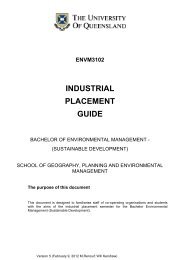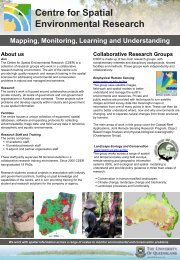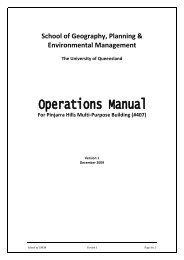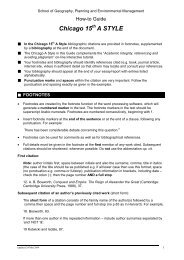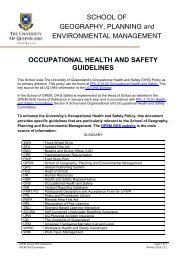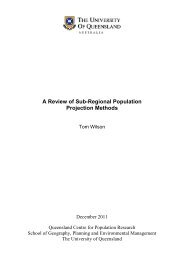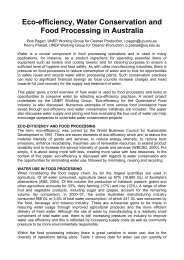Conserving Biodiversity in Brigalow Regrowth - School of ...
Conserving Biodiversity in Brigalow Regrowth - School of ...
Conserving Biodiversity in Brigalow Regrowth - School of ...
You also want an ePaper? Increase the reach of your titles
YUMPU automatically turns print PDFs into web optimized ePapers that Google loves.
Manag<strong>in</strong>g dense <strong>Brigalow</strong> regrowth:<br />
To th<strong>in</strong> or not to th<strong>in</strong>?<br />
<strong>Brigalow</strong> regrowth is <strong>of</strong>ten very dense (sometimes > 15,000 stems per hectare) because <strong>of</strong> the plentiful root suckers<br />
produced follow<strong>in</strong>g clear<strong>in</strong>g. Very high densities are particularly common after multiple pull<strong>in</strong>g attempts on deep<br />
clay soils with gilgais.<br />
Stems compete <strong>in</strong>tensely with one<br />
another and grow slowly, so slowly<br />
that dense stands are <strong>of</strong>ten described<br />
as “stunted” or “locked up”. Given<br />
enough time, dense brigalow regrowth<br />
will almost certa<strong>in</strong>ly grow <strong>in</strong>to<br />
woodlands ak<strong>in</strong> to virg<strong>in</strong> stands, but is<br />
it possible to speed up the process by<br />
th<strong>in</strong>n<strong>in</strong>g manually? The answer is yes.<br />
An experimental th<strong>in</strong>n<strong>in</strong>g trial <strong>in</strong> dense<br />
27 year old regrowth near Millmerran<br />
showed that th<strong>in</strong>n<strong>in</strong>g to 4000 – 6000<br />
stems per hectare produces the best<br />
results for woodland recovery and<br />
wildlife habitat. More severe th<strong>in</strong>n<strong>in</strong>g<br />
will open up the canopy and allow<br />
grasses to establish. While this might<br />
seem a positive result for graz<strong>in</strong>g<br />
purposes, it is not so good for wildlife.<br />
High grass cover, particularly buffel<br />
grass, <strong>in</strong>creases the risk <strong>of</strong> fire (see<br />
pgs 10 & 19), which will slow down the<br />
restoration process by kill<strong>in</strong>g trees or<br />
promot<strong>in</strong>g even thicker regrowth.<br />
If the goal is to manage brigalow<br />
regrowth for wildlife habitat, then<br />
canopy cover should be ma<strong>in</strong>ta<strong>in</strong>ed at<br />
more than 50% (i.e. on average more<br />
than half <strong>of</strong> the ground is shaded by<br />
tree canopy) <strong>in</strong> southern Queensland<br />
and northern New South Wales. In<br />
central and northern brigalow regions<br />
we recommend ma<strong>in</strong>ta<strong>in</strong><strong>in</strong>g tree cover<br />
at 70% because buffel grass grows<br />
more vigorously <strong>in</strong> these regions.<br />
In younger regrowth (e.g. 10–15 years<br />
old) it will be necessary to reta<strong>in</strong> more<br />
stems <strong>in</strong> order to ma<strong>in</strong>ta<strong>in</strong> adequate<br />
tree cover. In these cases it may be<br />
best to th<strong>in</strong> <strong>in</strong> stages, for example th<strong>in</strong><br />
down to 10,000 stems per ha <strong>in</strong>itially,<br />
then a few years later th<strong>in</strong> down to<br />
6,000 stems per ha.<br />
If provid<strong>in</strong>g habitat for native fauna<br />
is not the primary goal <strong>of</strong> manag<strong>in</strong>g<br />
regrowth, then the manager might<br />
want to encourage the growth <strong>of</strong><br />
<strong>in</strong>troduced pasture grasses and<br />
manage fire risk by graz<strong>in</strong>g. It is<br />
16<br />
important to know that sites that are<br />
managed <strong>in</strong> this way will not support<br />
the same richness <strong>of</strong> fauna that they<br />
would if managed <strong>in</strong> the way we<br />
describe, as wildlife habitat. However,<br />
from a wildlife perspective, some trees<br />
are better than no trees at all, and so<br />
the more common fauna will even use<br />
regrowth areas which are managed for<br />
graz<strong>in</strong>g and stock shelter.<br />
Th<strong>in</strong>n<strong>in</strong>g methods<br />
Obviously r<strong>in</strong>gbark<strong>in</strong>g takes a lot <strong>of</strong><br />
time and effort, and there may be more<br />
efficient methods available. Regardless<br />
<strong>of</strong> the method used, secondary<br />
sucker<strong>in</strong>g will occur less if th<strong>in</strong>n<strong>in</strong>g is<br />
done after good ra<strong>in</strong>. When th<strong>in</strong>n<strong>in</strong>g, it<br />
is important to reta<strong>in</strong> a range <strong>of</strong> stem<br />
sizes <strong>in</strong> a “natural” arrangement.<br />
For example, a completely random<br />
selection <strong>of</strong> stems yields very natural<br />
arrangements.<br />
Th<strong>in</strong>n<strong>in</strong>g for carbon<br />
Trees sequester carbon as they grow,<br />
but some species sequester more<br />
carbon than others. <strong>Brigalow</strong> is a<br />
high biomass species, mean<strong>in</strong>g that<br />
it stores a lot <strong>of</strong> carbon compared to<br />
other species from a similar climate.<br />
<strong>Brigalow</strong> regrowth therefore has<br />
considerable potential to be used<br />
as carbon s<strong>in</strong>ks. Although th<strong>in</strong>n<strong>in</strong>g<br />
releases some carbon (through the<br />
decay <strong>of</strong> treated stems), th<strong>in</strong>ned<br />
stands will recoup this carbon quickly<br />
and reach their carbon capacity sooner<br />
than unth<strong>in</strong>ned stands. Although<br />
slower, unth<strong>in</strong>ned stands are still likely<br />
to sequester carbon reasonably<br />
quickly.




